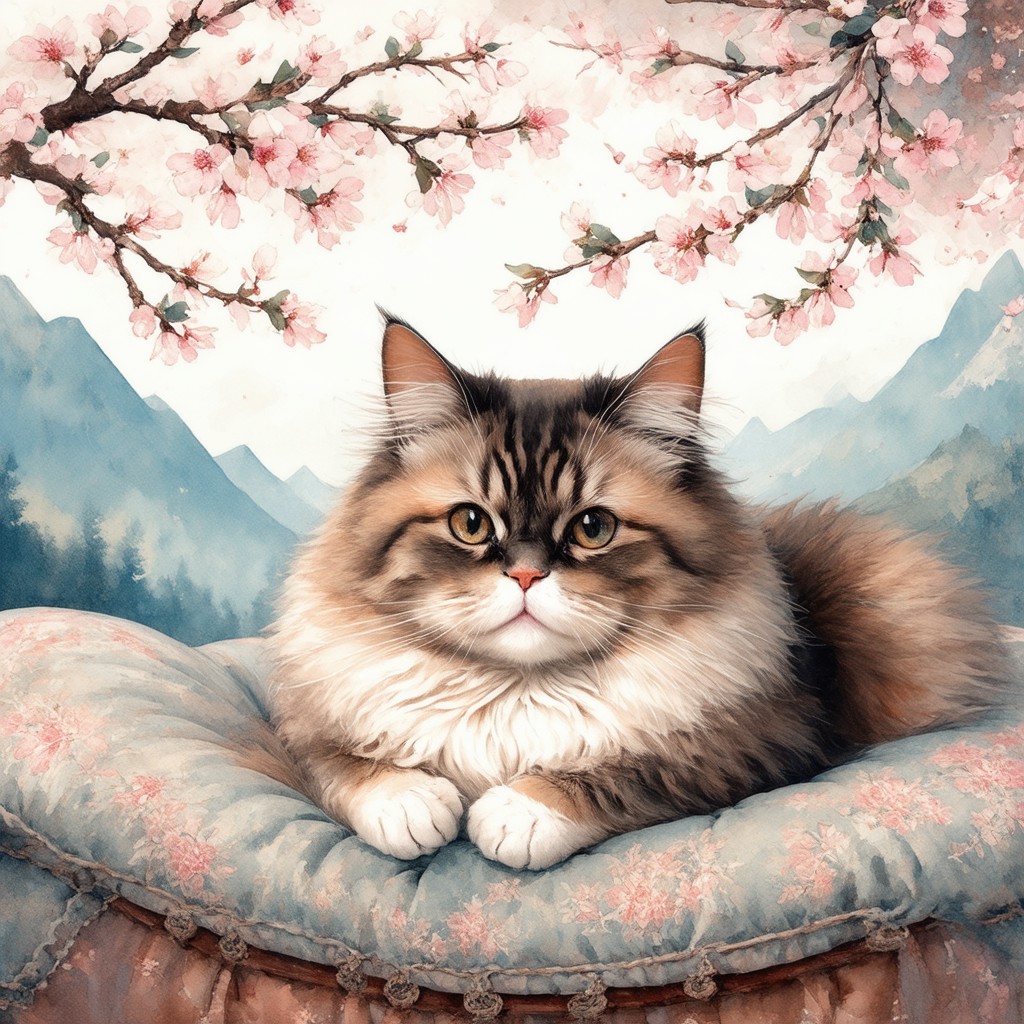Key Takeaways
- Cost Considerations: Expect to pay between $500 and $2,500 for a Himalayan cat, depending on factors like pedigree and breeder reputation.
- Affectionate Companions: Himalayans are known for their gentle, loving nature, making them ideal pets for families and individuals.
- Health Awareness: Be mindful of health issues such as respiratory problems and dental concerns common in Himalayan cats.
- Daily Grooming Required: Their long fur necessitates daily grooming to prevent matting and maintain coat health.
- Adaptable Pets: Himalayan cats can thrive in various living environments, from busy households to quiet apartments.
- Lifespan Insights: With proper care, Himalayan cats typically live between 12 to 15 years, with some reaching their late teens.
Welcome to our comprehensive guide on the Himalayan cat, a breed renowned for its striking beauty and gentle temperament. In this article, we will delve into everything you need to know about these charming felines, from the cost of a Himalayan cat to their unique personality traits and care considerations. Whether you’re contemplating adopting a Himalayan kitten or simply curious about their behavior, we’ve got you covered. We will explore the health concerns specific to Himalayan cats, their average lifespan, and the various colors that make them so distinctive. Additionally, we will provide insights into where to find Himalayan kittens for sale and tips for ensuring a smooth adoption process. Join us as we uncover the delightful world of the Himalayan cat and help you decide if this breed is the perfect fit for your home.
Himalayan Cat Cost Breakdown
The cost of a Himalayan cat can vary significantly based on several factors. Here’s a detailed breakdown:
- Average Cost: Generally, you can expect to pay between $500 and $2,500 for a Himalayan kitten from a reputable breeder. This price range reflects the quality and lineage of the cat.
- Show-Quality Cats: Himalayan cats that are bred for shows, often with extensive pedigrees, can command prices of $2,500 or more. These cats are typically bred to meet specific breed standards and may have superior traits.
- Pet-Quality Cats: A “pet quality” Himalayan, which may not meet show standards but still has desirable traits, might cost a few hundred dollars, typically ranging from $300 to $800.
- Adoption Options: Adopting a Himalayan cat from a shelter or rescue organization is a more affordable option, often costing between $100 and $300. This route not only saves money but also provides a home to a cat in need.
- Factors Affecting Price:
- Pedigree: Cats with show-quality pedigrees are more expensive due to their lineage and breeding.
- Coat Color: Certain coat colors, such as the rare lilac or chocolate points, may be more sought after, leading to higher prices.
- Breeder Reputation: Reputable breeders who adhere to ethical breeding practices and provide health guarantees often charge more for their kittens.
- Other Names: Himalayan cats are also known as “Himmies” or “Colorpoint Persians,” reflecting their unique appearance and heritage.
For more information on responsible pet ownership and the benefits of adopting, consider resources from organizations like the American Society for the Prevention of Cruelty to Animals (ASPCA) or the Cat Fanciers’ Association (CFA).
Factors Influencing Himalayan Cat Price
Several factors can influence the price of a Himalayan cat, making it essential for potential owners to understand these elements before making a purchase:
- Breeder Quality: The reputation and ethical practices of the breeder play a significant role in pricing. Reputable breeders often charge more due to their commitment to health testing and responsible breeding.
- Location: Prices can vary by region, with urban areas typically seeing higher costs due to demand and living expenses.
- Health Certifications: Cats that come with health guarantees and certifications may be priced higher, as these documents assure buyers of the cat’s well-being.
- Market Demand: The popularity of Himalayan cats can fluctuate, impacting their prices. During peak demand, prices may rise significantly.
Understanding these factors can help you make an informed decision when considering a Himalayan kitten for sale or adopting from a rescue.

Are Himalayan Cats Good Pets?
Himalayan cats are considered excellent pets for various reasons:
- Affectionate and Social: Himalayan cats are renowned for their friendly and affectionate nature. They thrive on human interaction and often seek attention, making them ideal companions for families and individuals alike. According to a study published in the Journal of Veterinary Behavior, social interaction is crucial for the emotional well-being of cats, and Himalayans excel in this area.
- Calm and Laid-Back: These cats are typically calm and quiet, preferring a serene environment over high-energy play. Their laid-back demeanor makes them suitable for households that value tranquility. The American Animal Hospital Association emphasizes the importance of a stress-free environment for pets, which aligns well with the temperament of Himalayan cats.
- Adaptable: Himalayan cats are adaptable to various living situations, whether in a bustling household or a quieter setting. Their ability to adjust to different routines makes them versatile pets. Research from the American Association of Feline Practitioners highlights that adaptability in pets can lead to better overall health and happiness.
- Good with Children and Other Pets: When introduced properly, Himalayans can coexist harmoniously with children and other pets. Their gentle nature often makes them a good choice for families. The ASPCA recommends gradual introductions to ensure positive interactions, which is particularly effective with this breed.
- Require Daily Grooming: With their long, luxurious fur, Himalayan cats require daily grooming to prevent matting and maintain coat health. Regular grooming not only keeps their fur in top condition but also strengthens the bond between the cat and its owner. The Cat Fanciers’ Association advises that grooming can also serve as a form of social interaction.
- Not Hypoallergenic: While Himalayan cats are beautiful and affectionate, they are not hypoallergenic. Individuals with allergies may experience reactions due to the cat’s dander and saliva. The Asthma and Allergy Foundation of America notes that no cat breed is completely hypoallergenic, but some may produce fewer allergens.
- Lifespan: Himalayan cats typically have a lifespan of 10-15 years, which is comparable to other breeds. Providing a balanced diet, regular veterinary care, and a loving environment can contribute to their longevity. The Cornell Feline Health Center emphasizes the importance of preventive care in extending a cat’s life.
In summary, Himalayan cats can be wonderful pets due to their affectionate nature, adaptability, and compatibility with families. However, potential owners should be prepared for their grooming needs and consider any allergy concerns.
Himalayan Cat Temperament and Personality Traits
The personality of Himalayan cats is characterized by several distinct traits that make them unique:
- Gentle and Affectionate: Himalayan cats are known for their sweet disposition. They enjoy cuddling and often seek out their owners for affection, making them great companions.
- Quiet and Reserved: Unlike some more vocal breeds, Himalayans tend to be quieter. They may not meow frequently, which can be appealing to those who prefer a more serene environment.
- Playful Yet Calm: While they enjoy playtime, Himalayan cats are not overly energetic. They appreciate interactive toys but also enjoy lounging around, making them suitable for various lifestyles.
- Intelligent and Curious: These cats are intelligent and curious, often exploring their surroundings. They benefit from mental stimulation through toys and interactive play.
- Social and Loyal: Himalayans form strong bonds with their owners and can be quite social. They thrive on companionship and may follow their humans around the house.
Understanding the temperament and personality traits of Himalayan cats can help potential owners determine if this breed aligns with their lifestyle and preferences. Their affectionate and calm nature makes them a popular choice among cat lovers.
Do Himalayan Cats Like to Be Held?
Himalayan cats, known for their striking appearance and gentle temperament, generally enjoy being held and cuddled. These affectionate felines thrive on human interaction and often seek out their owners for companionship. Here are some key points regarding their behavior and preferences:
- Affectionate Nature: Himalayan cats are known for their loving disposition. They often show a strong attachment to their owners, which makes them more inclined to enjoy being held and cuddled.
- Social Interaction: These cats are highly social and enjoy spending time with their families. They often greet their owners at the door, indicating their desire for connection and interaction.
- Calm Demeanor: Unlike some more energetic breeds, Himalayans tend to have a calm and laid-back personality. This makes them more amenable to being held for extended periods, as they appreciate the comfort and security that comes from close physical contact.
- Playful Yet Gentle: While they enjoy playing with toys, their play style is typically more subdued compared to other breeds. This gentle nature complements their preference for being held, as they are less likely to engage in wild antics.
- Health Considerations: It’s important to handle Himalayan cats with care, especially considering their brachycephalic (short-nosed) structure, which can lead to breathing difficulties. Always support their body properly when holding them to ensure their comfort.
In summary, Himalayan cats do enjoy being held, thanks to their affectionate and social nature. Providing them with love and attention not only strengthens your bond but also contributes to their overall well-being. For more insights into feline behavior and care, you can refer to resources from the American Society for the Prevention of Cruelty to Animals (ASPCA) and the Cat Fanciers’ Association (CFA).
Understanding Himalayan Cat Behavior
Understanding the behavior of Himalayan cats is crucial for fostering a strong bond with them. Their unique traits can help owners create an environment that meets their needs:
- Curiosity: Himalayan cats are naturally curious and enjoy exploring their surroundings. Providing them with safe spaces to investigate can keep them mentally stimulated.
- Vocalization: While not as vocal as some breeds, Himalayans do communicate through soft meows and purrs, especially when they seek attention or affection.
- Routine Lovers: These cats thrive on routine, so maintaining a consistent schedule for feeding and playtime can help them feel secure.
- Preference for High Places: Himalayans enjoy climbing and perching in high spots, so providing cat trees or shelves can cater to their climbing instincts.
By understanding these behaviors, you can create a nurturing environment that enhances your Himalayan cat’s happiness and well-being.
Socialization Tips for Himalayan Cats
Socializing your Himalayan cat is essential for their development and happiness. Here are some effective tips to ensure your feline friend feels comfortable and secure:
- Early Exposure: Introduce your Himalayan kitten to various people, pets, and environments early on to help them adapt to new experiences.
- Positive Reinforcement: Use treats and praise to encourage your cat when they interact positively with others, reinforcing good behavior.
- Gentle Handling: Always handle your Himalayan cat gently, especially during their formative months, to build trust and comfort with human interaction.
- Playtime: Engage in interactive play sessions to strengthen your bond and help them develop social skills. Toys that mimic prey can be particularly stimulating.
By following these socialization tips, you can help your Himalayan cat develop into a well-adjusted and affectionate companion.
What is the personality of a Himalayan cat?
Himalayan cats, often referred to as “Himmies,” are known for their unique and endearing personalities. Here are some key characteristics that define the personality of a Himalayan cat:
- Affectionate Companions: Himalayans are renowned for their loving nature. They thrive on human interaction and often seek out their owners for cuddles and companionship. This breed enjoys being close to their pet parents, often following them around the house.
- Intelligent and Curious: These cats are quite intelligent, displaying curiosity about their surroundings. They enjoy interactive play and mental stimulation, which can be provided through puzzle toys and engaging activities.
- Calm and Gentle Temperament: Himalayans are typically calm and gentle, making them excellent pets for families and individuals alike. They are known to be patient and tolerant, which is especially beneficial in households with children or other pets.
- Vocal Communication: While not overly vocal, Himalayans will communicate their needs and desires through soft, melodic sounds. They may express their feelings if they feel neglected or require attention.
- Social and Playful: Despite their laid-back demeanor, Himalayans enjoy playtime and social interaction. Regular play sessions can help keep them physically and mentally stimulated, contributing to their overall well-being.
- Adaptability: This breed can adapt well to various living situations, whether in a bustling household or a quieter environment. However, they do prefer a stable routine and may become stressed with significant changes.
For more insights into the personality traits of Himalayan cats, consider consulting resources such as the Cat Fanciers’ Association or the American Society for the Prevention of Cruelty to Animals (ASPCA). These organizations provide valuable information on cat behavior and care, ensuring that potential owners understand the needs and characteristics of this affectionate breed.
Key characteristics of Himalayan cats
The characteristics of Himalayan cats extend beyond their affectionate nature. Here are some additional traits that define this beloved breed:
- Distinctive Appearance: Himalayan cats are known for their striking blue eyes and long, luxurious fur, which often features a color-point pattern similar to that of the Siamese. Their round faces and short noses contribute to their charming looks.
- Low Activity Level: While they enjoy playtime, Himalayans are generally less active than some other breeds. They prefer lounging around and may not require as much exercise, making them suitable for apartment living.
- Grooming Needs: Due to their long fur, Himalayan cats require regular grooming to prevent matting and hairballs. This grooming routine can also serve as a bonding experience between the cat and its owner.
- Health Considerations: Like many purebred cats, Himalayans can be prone to certain health issues, including respiratory problems and genetic conditions. Regular veterinary check-ups are essential to monitor their health.
Understanding these characteristics can help potential owners appreciate the unique personality of Himalayan cats and provide the best care possible. For more information on caring for your Himalayan cat, check out our article on kitten care.

Are Himalayan Cats Lap Cats?
Yes, Himalayan cats are indeed considered lap cats, and their temperament makes them ideal companions for those seeking affectionate pets. Here are some key points about their personality and behavior:
- Calm and Affectionate Nature: Himalayan cats inherit the gentle and loving demeanor of their Persian ancestors. This calm disposition allows them to enjoy cuddling and being close to their owners, making them perfect lap companions.
- Playful and Curious Traits: Alongside their affectionate nature, Himalayans also exhibit playful and curious behaviors, reminiscent of their Siamese lineage. This combination of traits ensures that they are not only loving but also engaging and entertaining pets.
- Social Interaction: These cats thrive on social interaction and often seek out their owners for companionship. They enjoy being petted and will often curl up in your lap, seeking warmth and affection.
- Adaptability: Himalayan cats adapt well to various living environments, making them suitable for both apartments and larger homes. Their calm nature allows them to adjust to different lifestyles, as long as they receive adequate attention and love.
- Health Considerations: While they are generally healthy, Himalayans can be prone to certain genetic conditions, such as respiratory issues due to their brachycephalic (flat-faced) structure. Regular veterinary check-ups are essential to ensure their well-being.
In summary, Himalayan cats are quintessential lap cats, combining the affectionate traits of Persians with the playful spirit of Siamese. Their need for companionship and their gentle nature make them wonderful pets for families and individuals alike. For more insights into cat behavior and care, resources such as the ASPCA and the Cat Fanciers’ Association provide valuable information.
The Affectionate Nature of Himalayan Cats
The affectionate nature of Himalayan cats is one of their most endearing qualities. They are known for forming strong bonds with their owners, often following them around the house and seeking out their company. This breed enjoys being held and cuddled, making them ideal for those who appreciate a loving companion. Their gentle demeanor allows them to coexist peacefully with children and other pets, enhancing their appeal as family pets.
Differences Between Himalayan and Other Cat Breeds
When comparing Himalayan cats to other breeds, such as the Ragdoll or Siamese, several differences emerge. While Ragdolls are also known for their affectionate nature, Himalayans tend to be more reserved and calm. In contrast, Siamese cats are often more vocal and energetic. Understanding these differences can help potential cat owners choose the right breed that fits their lifestyle and preferences. For those considering a Himalayan cat, it’s essential to recognize their unique traits, which include a laid-back personality and a penchant for companionship.
Himalayan Cat Health Issues
Understanding the common health concerns associated with the Himalayan cat breed is crucial for any potential owner. These cats, known for their striking appearance and gentle temperament, can be prone to specific health issues that require attention and care.
Common Health Concerns in Himalayan Cats
Himalayan cats are susceptible to several health problems, primarily due to their brachycephalic (short-nosed) structure. Some of the most common health issues include:
- Respiratory Problems: The flat face of the Himalayan Persian cat can lead to breathing difficulties, especially in hot or humid weather.
- Dental Issues: Due to their jaw structure, Himalayans often experience dental problems, including overcrowded teeth and gum disease.
- Polycystic Kidney Disease (PKD): This genetic condition can lead to kidney failure and is more prevalent in Persian and Himalayan breeds.
- Eye Conditions: Himalayans are prone to various eye issues, including cataracts and corneal ulcers, which can affect their vision.
Regular veterinary check-ups and a proper diet can help mitigate these health risks. For the best cat food for Himalayan cats, consider options that support their unique health needs.
Preventive Care for Himalayan Cat Health
Preventive care is essential for maintaining the health of your Himalayan cat. Here are some tips to ensure your feline friend stays healthy:
- Regular Vet Visits: Schedule annual check-ups to monitor for any potential health issues early on.
- Dental Care: Implement a dental care routine, including brushing their teeth and providing dental treats to prevent gum disease.
- Weight Management: Keep an eye on your cat’s weight, as obesity can exacerbate health issues. A balanced diet tailored to their needs is crucial.
- Hydration: Ensure your Himalayan has access to fresh water at all times, as hydration is vital for kidney health.
By being proactive about your Himalayan cat’s health, you can help them live a longer, happier life. For more information on adopting a Himalayan cat, check out ASPCA and Petfinder for resources and adoption options.
Himalayan Cat Lifespan
Average Lifespan of Himalayan Cats
The average lifespan of a Himalayan cat typically ranges from 12 to 15 years. However, with proper care, some Himalayan cats can live into their late teens. Factors such as genetics, diet, and overall health significantly influence their longevity. Regular veterinary check-ups and a balanced diet are essential for maintaining the health of your Himalayan cat.
Factors Affecting the Lifespan of Himalayan Cats
Several factors can affect the lifespan of Himalayan cats:
- Genetics: Like many purebred cats, Himalayans may be predisposed to certain genetic conditions that can impact their health and lifespan.
- Diet: Feeding your Himalayan cat high-quality food, such as the best cat food for Himalayan cats, ensures they receive the necessary nutrients for a healthy life.
- Healthcare: Regular veterinary visits can help detect and treat health issues early, contributing to a longer lifespan.
- Environment: A safe, stimulating environment can reduce stress and promote physical activity, which is beneficial for overall health.













